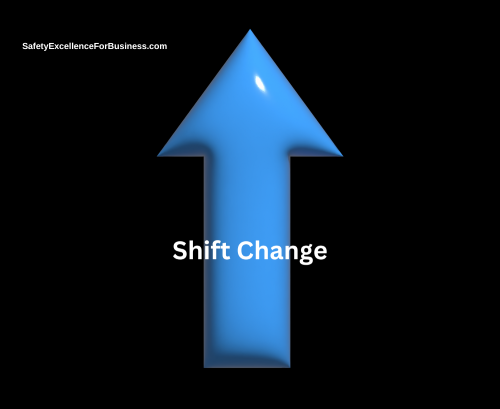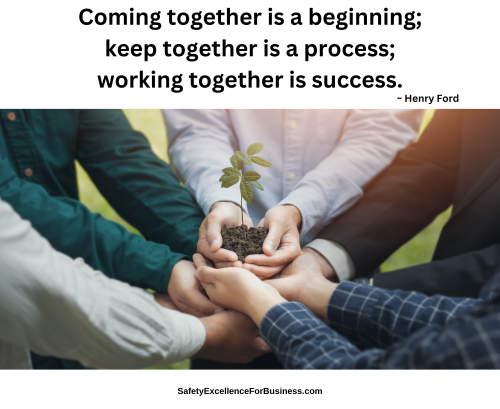We should be shifting our thinking and behavior.
I have written a lot about our whole safety system in the US being stuck for the last 8 years, with about 5,200 fatalities and 2,400,000 serious injuries a year. There is a lot of effort by many people, but the results are not getting better. That’s why we should be shifting our thinking and behavior.
I have also written and spoken a lot about Partner Centered Leadership, which is a very effective process to help organizations get a lot better in all dimensions of performance. In this process everyone thinks and works together with caring, respect, honesty, and trust. We all help each other to be our best.

Partner Centered Leadership requires a significant shift in how the managers lead.
I used to use the hard, top-down management approach. But I had to shift my thinking and behavior to being more open, really caring and working with the people, listening and learning together.
This is not just trying to be a better top-down manager. It is a complete shift to real partnering and caring.
The way I thought about the people and the huge knowledge they have about their actual work had to change. I had to learn to talk with the people and not at them. I had to listen.
Organizations are complex adaptive systems behaving more like a living system than a machine. No one has all the answers, so we had to co-create our future together. We found that our collective knowledge and intelligence were amazing. As this became revealed in our work, we all got more and more excited about what we were trying to do.
We discovered a relatively simple complexity tool called the Process Enneagram that we could use together so we could:
- see the whole system in which we were working,
- see the various parts and
- see how they interacted.
This was the first time we could see this way; it really helped us.
The Three Levels of Work
As we learned, we also became quite conscious of different, interdependent, interacting, simultaneous levels of work processes. When you watch a soccer game you can see the three levels of activities.
- At the Level 1, the players on the field are self-organizing as the game unfolds. They are making instantaneous decisions using the clues and actions they take in as they play. The best decisions are made by them as the game goes on.
- At Level 2, the coaches on the side lines are making decisions based on what they are seeing. They see different things. They will call in plays, make decisions about replacing a tired player, think about improving or adjusting the over-all strategy, and cheer the players to perform better.
- At Level 3, the referees make sure the conditions for the game are consistent with the league rules. They work on stuff like proper ball pressure, and the correct markings on the field as well as making sure everyone is playing fairly, calling penalties and managing the over-all game. If the players and coaches do not play by the agreed upon rules, the game will fall apart and no longer be soccer.
In Partner Centered Leadership, all three levels are working. Together we co-create the agreements of how we are going to live and work together at Level 3. All of us are accountable and take responsibility for them. The Level 3 agreements govern everything and are the difference in whether the organization is successful or not.
Those of us in management or leadership positions are at Level 2; we respectfully interact with the people sharing information about how the people and the business are doing. We ask for their help and ideas about how to get better. We encourage people to make decisions close to their work, with consultation with others who are also close and knowledgeable. We also use our situational awareness as we interact sensing problems like bullying or harassment, or how the organization is feeling at that moment, etc.
Those doing the actual, physical work at Level 1 are constantly learning and sharing so we are all improving. Making decisions close to work is usually the best place to make them. This is like the idea of “work-as-done” and “work-as-imagined.”
Shifting Our Thinking and Behavior: Partner Centered Leadership
When I was the plant manager, walking the plant every day, I operated at Levels 2 and 3. At Level 2 I talked respectfully with the people to help to build trust and interdependence. I shared lots of information about all we were doing. I also encouraged their decision-making, praising their successes. I also apologized for my mistakes.
I also worked at Level 3 as I talked about our agreements on how we wanted to work together. I would watch what was going on praising good behaviors, and if I detected poor behavior, we would talk about it. Rarely, I would have to address a bullying or harassment problem; these cannot be ignored since they are like a rotten apply and will spoil everything unless the behavior is eliminated.
I rarely worked at Level 1 since the operators, mechanics, engineers, first line supervisors, and safety people (we had 4 safety people) knew far more than I did. My Level 2 and 3 work enabled them to grow and be their best.
In leading this way, all 1,300 of us together, reduced injuries by 97%, and emissions to the environment by 95%. Our productivity rose by 45% and earnings rose by 300%. We did this in just 4 years.
Partner Centered Leadership really helped us all to get a lot better!
The shift in thinking and doing is worth it!

Shifting our thinking and doing are critical in helping to lead our organizations to a successful, safer and more prosperous future. Partner Centered Leadership will really help your organization to prosper.
I’m heartened to learn about the Safety Futures’ – Advanced Safety Professional Practice, a 12-week program under David Provan, (Melbourne, Australia), having recently graduated 100 newly-enlightened Safety Professionals. This program covers the critical professional practice capabilities that are not taught well in other health and safety professional development programs. Click here for David’s LinkedIn profile.





